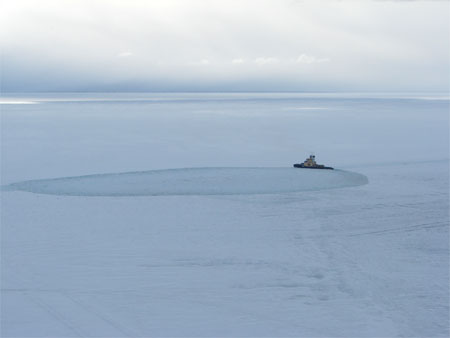Not shipshapeCoast Guard icebreaker may not be available for standby duty for 2010-11 seasonPosted July 9, 2010
The U.S. Coast Guard However, this shouldn’t affect the annual icebreaking mission to the Ross Sea. The National Science Foundation (NSF) The channel from the ice edge to the station allows the annual resupply and fuel ships access to McMurdo. 
Photo Credit: Peter Rejcek/Antarctic Photo Library
The USCG cutter Polar Sea next to the annual fuel ship at McMurdo Station in February 2007.

Photo Credit: George Blaisdell/Antarctic Photo Library
Swedish icebreaker Oden carves a turning basin to allow non-icebreakers to turn toward the ice pier at McMurdo Station.
The 108-meter-long Oden has served as the primary icebreaker for the USAP since the 2007-08 season. It is also a research vessel that supports joint U.S.-Swedish science missions each year. The Coast Guard said the Polar Sea will likely be in a maintenance status and unavailable for operations until at least January 2011. Its sister ship, the Polar Star The Polar Sea was commissioned into service on Feb. 23, 1978, and has exceeded its intended 30-year life. In 2006, the Coast Guard completed a rehabilitation project that extended its service life to 2014. The Coast Guard’s third icebreaker, the Healy Scientists aboard the ship are taking an up-close look at how changing conditions in the Arctic are affecting the ocean’s chemistry and ecosystems that play a critical role in global climate change. Built in 2000, the Healy is the most technologically advanced polar icebreaker in the three-vessel fleet, but it does not have the same ice-breaking capabilities as the two 122-meter-long ships based in Seattle. The Coast Guard assumed responsibility of the nation’s entire icebreaking fleet from the U.S. Navy in the 1960s. The Foundation charters two icebreaking research vessels, the Nathaniel B. Palmer and the Laurence M. Gould |



For USAP Participants |
For The Public |
For Researchers and EducatorsContact UsU.S. National Science FoundationOffice of Polar Programs Geosciences Directorate 2415 Eisenhower Avenue, Suite W7100 Alexandria, VA 22314 Sign up for the NSF Office of Polar Programs newsletter and events. Feedback Form |


